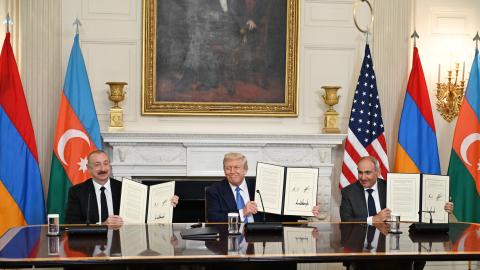Last week I wrote a column about the debate over the rationality of the Iranian regime. On one side of this policy debate are those who believe the regime is rational and therefore will pose little strategic threat to the United States and Israel should it acquire a nuclear weapon. On the other side are those who believe that the regime is irrational, and thus cannot be allowed to have the bomb since it cannot be deterred from using it. My conclusion was that the entire debate should be irrelevant to U.S. policy toward Iran, a country whose conduct--rational or not--already threatens our strategic interests and would surely become more threatening if bolstered by the bomb.
In order to illustrate both sides of the debate, I showed how one could argue--and some have argued--that the Iranian regime really is suicidal and even that the Iranian people as a whole had largely lost confidence and interest in the future that they are being offered by the mullahs. To that end, I suggested that rapidly declining birthrates in Iran could be taken as evidence that the Iranian people as a whole were choosing not to reproduce themselves, which in turn might suggest that, as a people, they preferred not to live.
"Preposterous," my colleague Michelle Goldberg writes in response. She argues that Iran's fertility rate, similar to that of Iceland and Chile, is evidence of "fitful modernization." Goldberg explains: "As education and opportunities increase for women, fertility rates go down. That's as true of Iran, where women now outnumber men by two to one in universities, as it is anywhere."
Goldberg's argument ignores the thrust of my column, which was that the debate over whether or not Iran was rational or suicidal was beside the point. Instead, she fastened on to a marginal sentence to defend her version of first-world feminist orthodoxy. The perhaps unintended result is that she winds up arguing that the Iranian regime is actually pro-feminist.
"Of course women are educated in Iran," Roya Hakakian, an Iranian-American author, told me. "But it's a silly argument. To create causality between a lower birth rate and women's opportunities is not scientific. Specifically, it doesn't take into account that marriage rates have dropped due to a depressed economy and high unemployment. It's gotten so bad that two or three years ago the government set aside a budget to subsidize marriages."
Goldberg is so committed to the idea that declining fertility rates are the result of increasing opportunities for women that she ignores the actual situation for women in the Islamic Republic. "Prostitution has skyrocketed," says Hakakian. "The economy has forced Iranian women to do things they never would've contemplated before."
The fact is that the Iranian government's "modernization" came to an end with the fall of the Pahlavi dynasty in 1979. A core component of this modernization drive was improving the status of women, which included the establishment of family-planning clinics.
From the outset, Khomeini's Islamic Republic set itself squarely against modernity. On the external front, this meant challenging the West, in particular the Great Satan: the United States. The internal enemy of the regime was the emancipated Iranian woman. As Goldberg notes, Khomeini was against family planning. The clerical regime closed and defunded clinics. The Supreme Leader, eager to export the Islamic revolution, called for a 20-million-man army, rising from the wombs of Iranian mothers.
"Khomeini said, 'have kids, we'll pay for it,' " says Banafsheh Zand-Bonazzi, an exiled Iranian working on a documentary about Iran's feminist movement. "They said, 'we'll pay for water, housing, education, everything.' "
Yet after the decade-long war with Iraq, the regime understood that it could not afford the blank check that the recently deceased Khomeini had written. The economy, reliant almost exclusively on the energy sector, could barely support its existing population, let alone adequate services for the nearly half a million disabled veterans returning from the Iraqi front.
The purpose of the regime's subsequent family-planning program was obviously not to empower women. Under the Islamic Republic, women have never been anywhere near equal to men. In Iran, a woman's testimony is worth half that of a man, and she is entitled to only half the inheritance due a male heir. Women are stoned for having sexual relationships contrary to the laws imposed on them by bearded clerics, and they are arrested for crimes such as wearing blue jeans and lipstick in public. Margaret Atwood would have a tough time imagining anything as patriarchal and oppressive.
It was fear that the youth bulge might come to threaten its economic and political privilege that motivated the regime to put an Islamic face on family-planning measures that the Khomeinist revolution had rejected. "They used slogans like 'the small family is a divine family,'" recalls Sohrab Ahmari, an Iranian-American writer, and a Tablet contributor, who left Tehran in 1998. The regime dispensed condoms and birth-control pills with the approbation of the clerics under the umbrella of a religiously ordained campaign that would give Goldberg the creeps if right-wing evangelicals were behind it.
Ahmadinejad, as Goldberg notes, is not happy with the declining birth rate. Like Khomeini, he wants more bodies to throw at the regime's enemies. "Iranian women didn't listen to him," writes Goldberg, perhaps imagining that they instead availed themselves of the "opportunities" the regime had on offer.
The truth is that there are few opportunities for Iranian women, or men for that matter. The same depressed social climate that has kept young Iranians from marrying and driven some women into prostitution is what sent young Iranians to the streets in June 2009. In retaliation, the regime waged a campaign of terror, targeting those most vulnerable in Iranian society: women. Some, like 25-year-old Neda Agha-Soltan, were shot to death in the streets, while others were jailed, tortured, and raped. In short, "fitful modernization" is a rather vicious euphemism to describe the Islamic Republic's position on the role of women in Iranian society.
Despite similar birth rates, Iran is nothing at all like Iceland and Chile. Surely Goldberg, as the author of a book about politics and birth rates, knows this. So, then why does this feminist align herself, even tacitly, with a ruling order that is founded on the medieval treatment of women? Perhaps it's just knee-jerk political warfare: That is, in order to score a point against those on the other side of this country's blessedly narrow political spectrum, she is willing to ignore the brutal reality inhabited by other people on the far side of the world.

















